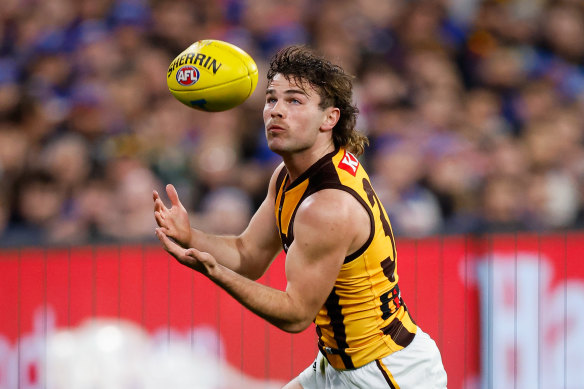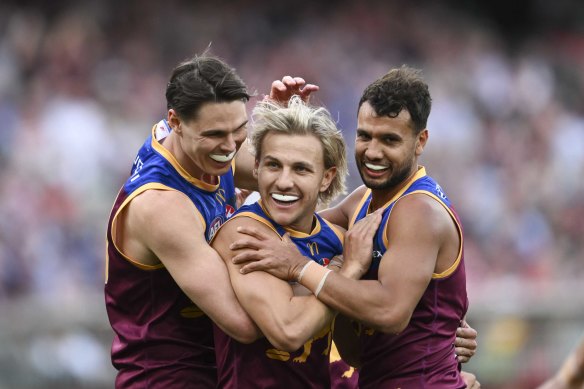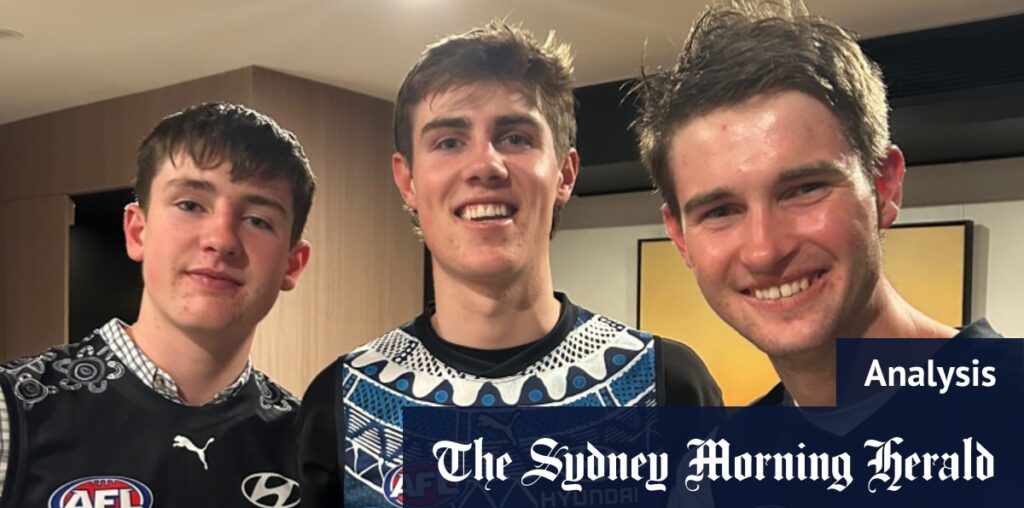Loading
“This has been the longest half an hour in my life,” Camporeale told Fox Footy.
Ben is a hard-running midfielder who can play inside and outside the contest, while Lucas is, like his father, a skilled wingman, though a left-footer.
The question now is who gets to wear their father’s No.16 jumper, which is up for grabs after Jack Carroll’s departure to St Kilda.
“We’ve made a deal throughout all our juniors whoever went first would get it,” Lucas said. “I’d like to think I’m dad’s favourite, so who knows?”
There was more nostalgia for success-starved North Melbourne fans, who now have another famous name from their glory period in the 1990s back at Arden Street.
River Stevens, the son of inspirational former midfielder Anthony Stevens, has joined Jackson Archer and Cooper Harvey as recent second-generation Kangaroos. Anthony Stevens and Glenn Archer were both key members of the 1996 and 1999 premierships, while Brent Harvey, also a flag winner in 1999, is the league’s games record holder.
“It’s been a dream of River’s for a long time since he’s been a kid, and he’s been a mad North supporter,” former North captain Anthony Stevens, said.
“It’s exciting to see the last couple of drafts. Jackson Archer and Cooper Harvey and now River being there.
“Hopefully, there’s a fairytale story in regards to where the footy club’s going at the moment.”
Stevens, a small forward described as a “no fuss” player by North recruiter Will Thursfield, was chaired into his school graduation celebration on the shoulders of his mates.
Key forward prospect Tyler Welsh landed at Adelaide, where his father Scott Welsh played 129 of his 205 games, while Jaren Carr is following in the footsteps of his 162-gamee father Matthew Carr at Fremantle.
Brisbane matched a bid at pick five on the first night to secure Levi Ashcroft, the younger brother of Norm Smith medallist Will Ashcroft and son of premiership player Marcus Ashcroft.
Is the era of the key forward over?
Coaching great Allan Jeans once said tall players don’t get shorter, but fast players get slower, highlighting the importance of key-position footballers.
This was the draft that went against that long-accepted convention.

Small forwards such as Nick Watson are increasingly important.Credit: AFL Photos
It was only 30 years ago that key forwards ruled the game – Jason Dunstall, Tony Lockett and Gary Ablett snr were among those who regularly bagged 100 goals a season.
It feels like an eternity ago now.
Midfielders dominated the class of 2024 and though key forwards still found a home, there was a shift in priority to speedier types.
Loading
The slide for key forwards was most dramatically illustrated by first-round heartbreak kid Jack Whitlock’s drop to 33. Only three were picked in the first round, compared to seven smaller forwards.
If the key forward mafia was a political party, their backroom powerbrokers would be aghast at their dwindling importance.
The trend towards faster forwards having more influence than their bigger teammates in finals was noted.
Take 2023, when Carlton’s back-to-back Coleman medallist Charlie Curnow did not fire a shot in a finals series that culminated in Collingwood’s Bobby Hill taking home the Norm Smith Medal. This year, unheralded Brisbane pair Callum Ah Chee and Kai Lohmann were unlikely heroes in the Lions’ flag, while Sydney’s three big forwards were hardly sighted.
“The small forwards are having a real impact on the game,” Melbourne’s recruiting manager Jason Taylor said.

Brisbane’s Kai Lohmann (centre) celebrates one of his four goals in the grand final with teammates Eric Hipwood and Callum Ah Chee.Credit: Eddie Jim
“The speed of ball movement and speed of the game is becoming quite apparent. A lot of these players are having high impact at the right time of the year in finals. That was really apparent this year.
“Maybe that’s something that we might see, more of the smaller forwards, speedier types having a real impact, not only up forward but pushing up further afield to open the game up.”
There has never been a greater need for speed to break down sophisticated defensive structures, firstly by pushing up the ground to assist in clearing the ball from defence, then in the foot race back to goal on rebound.
Richmond’s recent dynasty could not have happened without small forwards who had the mix of speed and endurance to pressure teams defensively and lock the ball near goal. Hawthorn’s brash, young forwards have made them an offensive weapon, headlined by Nick Watson, the pint-sized “Wizard” selected with pick five last year.
Greater Western Sydney, who have already built a fleet of small forwards the envy of many of their rivals, swelled their ranks with another two this year – Oliver Hannaford and Cody Angove – in the first round.
“I think there’s been a shift,” Port Adelaide recruiting manager Geoff Parker said. “You look at the smaller forwards that have come in. Hawthorn have developed a style of their own and other clubs are going a little bit that way as well.”
Though Port used pick 33 on 200-centimetre key forward Whitlock, who looms as a potential replacement for Charlie Dixon, the value they placed in small forwards was evident on Wednesday night when they traded out a pick to climb one spot to grab pacey small forward Joe Berry.
“The game’s shifted a little bit that way to quick ball movement, smaller in the forward-50, push up the ground, run back into space. That’s how we think it might be travelling the next few years.”
By necessity, Richmond, for whom this draft is the cornerstone of a rebuild, went against the flow. Unlike the genuine contenders at the other end of the ladder, they are nowhere near the point where they can top off their list with speed.
They picked the first two key forwards in the draft – Jonty Faull at 14 and Harry Armstrong at 23 – then for good measure opened proceedings on the second night by selecting ruck/forward Thomas Sims.
Their boom midfielders Sam Lalor and Josh Smillie are already hulking. Lalor’s shoulders are already broader than Trent Cotchin, the retired Tigers great who presented him his jumper, while Smillie’s frame made another former Richmond star, Jack Riewoldt, look in need of a visit to the gym.
Loading
Whereas many of his counterparts prioritised the value of speed in finals, Tigers recruiting guru Blair Hartley saw how the bigger bodies of Melbourne, Geelong and Brisbane came to the fore in their flags.
“The game’s fast but it’s also contest-based,” Hartley said. “You’re recruiting for the last day in September. So how do those games look, and how have they looked over time? Those are the things we assess.
“The game’s always getting faster. Just look at some of the athletes tonight. But when it comes back to the crunch of the big games, it’s a contest game. You need to have that too. You need guys who can play all around the square and we’ve tried to assess that as we assess this draft pool.”
If speed continues to prevail, the modern-day version of Jeans’ expression might go something like “tall players don’t get shorter, but they get slower faster”.
Keep up to date with the best AFL coverage in the country. Sign up for the Real Footy newsletter.

